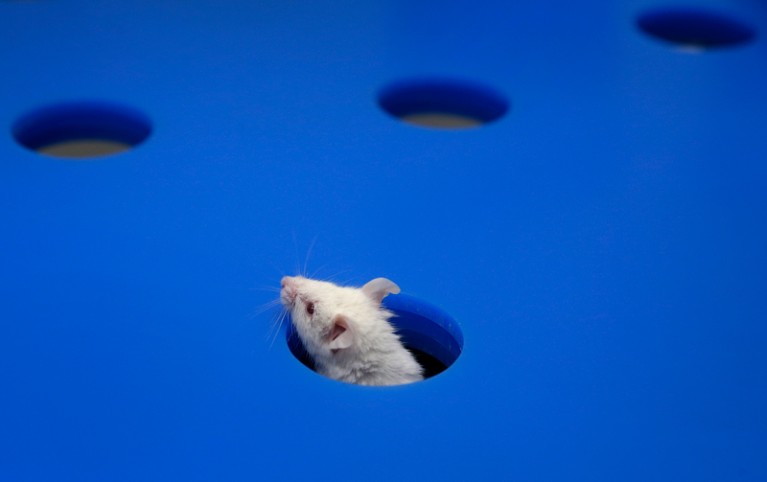[ad_1]

Biomedical advances mean there might be sound alternatives to using animals such as mice for testing.Credit: Paul Chinn/The San Francisco Chronicle/Getty
The future of drug development might be animal-free — or, at least, involve far fewer animals than is currently the norm. Last June, the US Food and Drug Administration (FDA) set out proposals for the New Alternative Methods Program that will focus on replacing, reducing and refining the use of laboratory animals through the adoption of cutting-edge alternative methods. The aim is to produce findings that are more relevant to humans, streamline product development and reduce costs.
The shift, which has been years in the making, would be undertaken across all of the FDA’s centres, including ones that oversee the approval of new pharmaceuticals, medical devices, veterinary medicines, cosmetics and more. FDA scientists are conducting their own research in service of this goal and are collaborating extensively with colleagues in industry, academia and other sectors of the US government. Any methods eventually adopted in place of research involving animals would be rigorously vetted and “fully validated and based on the best science”, says Namandjé Bumpus, chief scientist at the FDA. Bumpus and her colleagues have not received any pushback from researchers about making this shift, she adds, or heard any concerns from the scientific community about cutting back on the use of animals.
Although there is no set timeline, FDA officials say the programme is a priority. It would be funded from US$5 million it has requested as part of its 2023 budget to develop a ‘comprehensive strategy’ on alternative testing methods. According to Paul Locke, an environmental-health scientist and lawyer at Johns Hopkins University in Baltimore, Maryland, who specializes in alternatives to animal testing, the FDA is taking a necessary step towards ensuring that the US government stays up to speed with the latest science. “I’m really excited about what the FDA’s doing here,” he says. “They’ve put a stake in the ground and said, ‘Hey, we want to be there using these tools, they’re consistent with our mission and they’re consistent with what twenty-first-century science looks like.’”
Biomedical advances fuel alternatives
Animal-based testing has been the gold standard for research for decades, and it remains an important requirement for establishing the safety and efficacy of products being brought to market today. But key differences exist between humans and the rodents, rabbits, non-human primates and other animals that researchers depend on for testing, and as biomedical understanding has advanced, scientists have begun to come up against the limitations of using other species as proxies for humans. “A mouse or a rat doesn’t always handle or process medicines and chemicals in the same way humans do,” Bumpus says. “Developing more in vitro systems that are based on human cells, human tissues and human models could, in some instances, be more predictive.”
The FDA’s interest in moving towards new approaches also reflects the current thinking of the biomedical community at large. In 2014, the United Kingdom, for example, announced plans to reduce the use of animal tests in scientific research, aiming to replace those tests with ‘scientifically valid alternatives’ where possible. In 2021, the European Parliament voted in favour of plans to phase out animal testing in research.
“A key for bringing about change is to do so among the multiple major regulatory agencies,” says David Strauss, director of the FDA’s Division of Applied Regulatory Science. “Drug-development programmes are global, and companies want to market their products in many countries around the world.”
That sentiment is echoed by Bumpus. “There’s a lot of energy around this across the globe,” she adds.
Animal-rights advocates have been calling for an end to animal testing for years; now, methods being developed in labs around the world have made this a realistic possibility for the future. “We think we’re at a potential tipping point,” says Strauss. The technologies include, for example, induced pluripotent stem cells — cells that scientists program to have the potential to turn into any cell type found in the body — and ‘organs-on-a-chip’, which are small devices containing living human tissues that mimic an organ, organ system or even an entire body1. Developments in artificial intelligence and machine learning are also allowing scientists to harness existing data to build computer models that can make predictions about a new drug’s safety and efficacy.
More funding needed
In addition to being more relevant to humans, says Locke, once these types of technology are qualified and validated for specific uses, they will probably be faster and cheaper than using animals, allowing products to be brought to market more rapidly and efficiently. These are still early days, however, and so far, the FDA has only a handful of successful animal-testing-replacement stories it can point to.
Funding for developing and validating alternative methods is also an issue, Locke adds — both internally at the FDA, and externally for scientists whose labs depend on federal funds to pioneer new approaches. The FDA is not primarily a funding agency, and the US National Institutes of Health, which is the largest public funder of biomedical research in the world, currently has no programme dedicated to developing alternatives to animal testing. “If we had a legitimate funding programme to push these technologies forward, it would accelerate their progress greatly,” Locke points out.
For now, despite the promising alternatives to animal testing, federal regulators have approved only a few cutting-edge methods, and such techniques will not completely replace animal testing any time soon. But they do hold great promise, Locke says, especially if other government agencies and countries join the FDA in its effort.
“There’s a lot of moving pieces here,” he says. “The FDA has started the ball rolling, but we need more work to make sure we can use these new methodologies appropriately.”
[ad_2]
Source link

